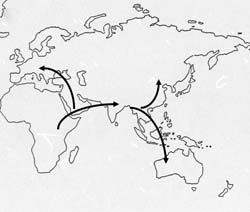
Human mitochondrial DNA (mtDNA), a circular molecule with 16,569 base pair length, encodes 13 proteins, 22 tRNAs, and 2 rRNAs. In the past few years, complete sequencing mtDNA genome has become a powerful tool to determine the matrilineal components and their evolutionary relationships (viz. phylogeny) and thus to gain some detailed insights into the past of modern humans. Hitherto, no similarly systematic study has been applied to South Asia--an important area which hosts a diverse conglomerate of people with different morphological, genetic, cultural and linguistic characteristics and has been suggested to serve as a key region for the dispersal of modern humans after the "Out-of-Africa" event.
To fill the lacuna, a research team leaded by Prof. ZHANG Yaping, an expert in molecular evolution and population genetics from Kunming Institute of Zoology, CAS, have completely sequenced 75 macrohaplogroup N representatives which were carefully selected from a collection of 1,200 mtDNAs sampled across India. Their results determined five novel haplogroups (viz. N5, R7, R8, R30, and R31) as well as another six known indigenous ones (viz. N1d, R5, R6, U2a, U2b, and U2c), which are pronouncedly different with the other haplogroups in other regions (Europe, East Asia and Oceania), and the separation time is estimated to be 60,000~70,000 years ago. Moreover, it turns out that the European mtDNA lineages observed in India have a close relationship with the typical European ones. The researchers believed that the high-level similarity and wide spreading of the European lineages in India indicated large-scale gene flow.
Their results are in agreement with the previous viewpoint on the peopling of South Asia. Based on the evidence from archeological, anthropological and genetic studies, it has been proposed that the modern Indian population resulted from three migration events: the first and most ancient one originated from the east Africa about 60,000 years ago, leading to the aboriginals in India; the second came from Near East about 10,000 years ago, which was related to the spreading of agriculture; and the third resulted from Aryan invasion about 4,000 years ago, laying a ground for the caste system in the country. In their results, the eleven indigenous haplogroups were derived from the most ancient migration and represented the aboriginals in India; while the European lineages indicated the gene flow since Neolithic from Fertile Crescent or Central Asia steppe.
Their results also shed more light on the migration mode of modern humans after "Out-of-Africa" exodus. The traditional view holds that there were two distinct migration routes after the "Out-of-Africa" event: a southern route along the Asian coastline and a northern route through the Levant to Near East, with haplogroup M dispersing along the southern route while N along the northern one. Prof. Zhang and colleagues' results, however, indicated that it was unlikely for the haplogroup N to enter India through the northern route. Instead, haplogroup N might have taken the same route together with M. That is, the "Out-of-Africa" dispersal is not a two-route but a single route migration along the Asian coastline. The aforementioned work was reported in
The American Journal of Human Genetics (75: 966-978).
Similar analysis has been performed on Indian haplogroup M lineages. By complete sequencing 56 representatives selected from more than 1200 Indian individuals which were proven to belong to haplogroup M on the basis of control-region and partially coding-region information, Zhang and colleagues identified seven novel indigenous haplogroups (M34-M40) and provided complementary information in supporting eight known ones (M2-M6, M18, M30, and M33). Their reconstructed phylogenetic tree covers nearly all Indian autochthonous M lineages and thus can serve as the basis for the subsequent mtDNA studies for the region.
The comparison of matrilineal components among India, East Asia, Southeast Asia, and Oceania at the deepest level revealed a star-like and non-overlapping pattern, thus reflecting a rapid dispersal mode of modern humans along the Asian coast after the initial "Out-of-Africa" event. This work was published (on-line) in
Molecular Biology and Evolution.





